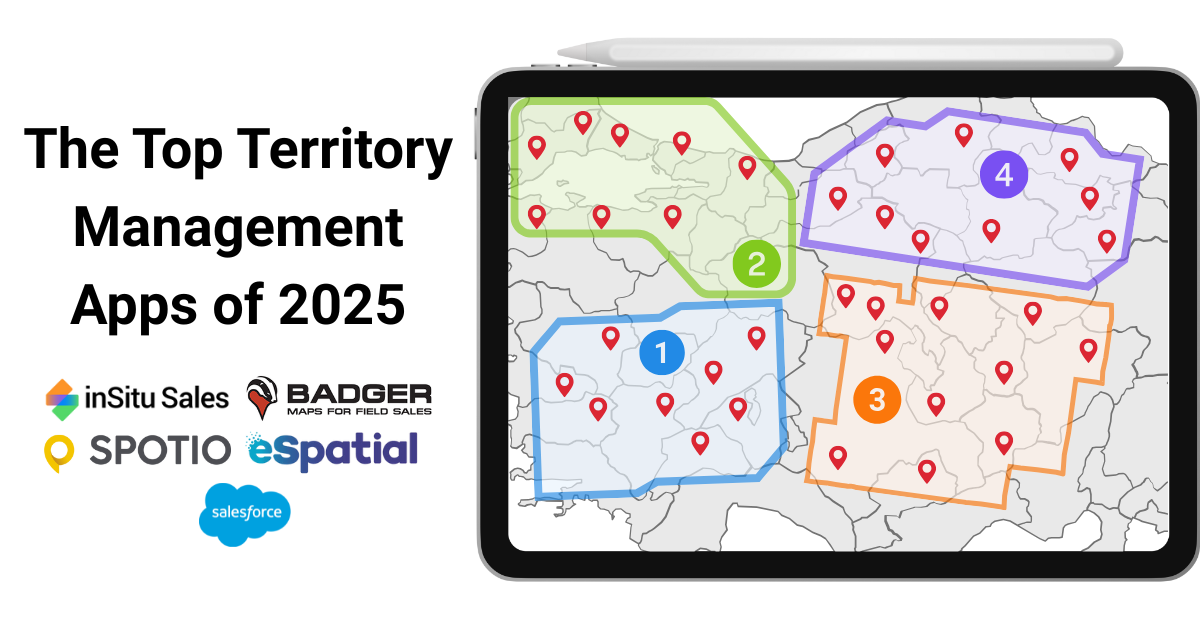
The Top Territory Management Apps of 2025
Managing sales territories has always been a critical part of distribution. When sales reps spend too much time in the wrong places, cover territories inefficiently, or miss opportunities because of poor visibility, your revenue and customer satisfaction suffer. In 2025, mobile territory management apps are transforming the way distributors assign, track, and optimize their field sales teams.
These tools help you map territories, plan routes, balance workloads, and sync sales activity back to your ERP. For wholesale distributors in particular, they are essential for making sure your reps are spending less time on the road and more time generating revenue.
In this article, we’ll cover the top mobile territory management apps for 2025, highlighting their features, benefits, and considerations — and why distributors should evaluate the right fit for their sales process.
Why Mobile Territory Management Apps Matter for Distributors
Distributors face unique challenges compared to other sales-driven businesses:
-
Large, complex territories often covering multiple regions or states.
-
Frequent in-person visits to customer storefronts that require precise scheduling.
-
Multiple reps, warehouses, and drivers all working across overlapping geographies.
-
ERP and inventory dependencies, meaning reps must know what’s in stock before taking orders.
Without modern mobile territory management tools, inefficiencies pile up: duplicated visits, missed customers, inconsistent territory coverage, and lost sales opportunities.
Some key benefits of territory management apps include:
- Improved resource allocation.
- Enhanced customer service with drastically fewer errors.
- More frequent and reliable reorders.
- Faster turnaround from order to invoice.
That’s why in 2025, the best apps are focused on real-time data, route optimization, ERP/CRM integration, and user-friendly mobile experiences.
The Top Territory Management Apps of 2025
1. inSitu Sales
Best for: A more complete all-in-one solution (sales reps, warehouse, dispatch, and ecommerce), and as the best cost for value option with beginners and budget conscious teams.
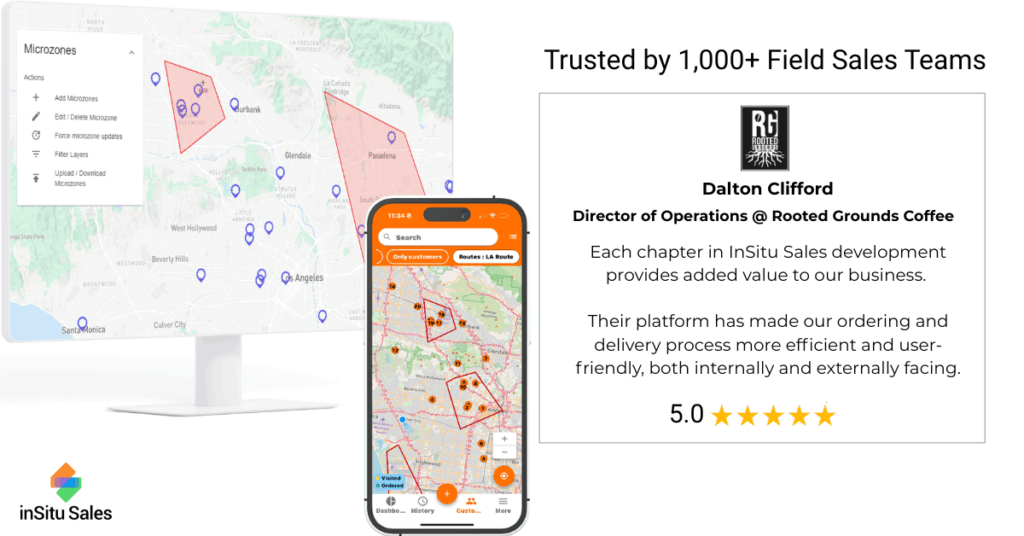
inSitu Sales is a favorite amongst wholesale distributors of all sizes due to being the most cost-efficient (after choosing a subscription plan, costs range from $20-$35 a month per user based on the volume of licenses), the easiest to learn (accessible support, video walkthroughs, and an online e-learning portal), and connects the entire sales workflow for pre-sales & DSD operations.
-
All-In-One Enterprise Solutions: Sales activities from field sales or B2B Ecommerce flow into warehouse picklists and delivery dispatch, keeping every team aligned with an automated sales cycle.
-
Territory Geofencing / Microzones: Create defined zones that will group together customers to easily assign them to reps, as well as being able to easily attach personalization options such as promotions, discounts, & price lists.
- Manage Assigned Customers: Customers grouped into territories can all have personalized targeting applied: such as promotions, discounts, price lists, and specific products available.
Why distributors like it: Companies that sell physical products directly in the field, need order and payment capture, and want a hands on approach to optimizing routes, guiding customer interactions, and visit frequency. Unlike most similar apps, inSitu Sales offers an all-in-one single enterprise solution to optimize every part of the sales cycle. That means less juggling multiple software licenses and more efficiency across reps, warehouses, and drivers.
2. Badger Maps
Best for: Highly detailed territory management map with filters and “what-if” scenarios, plus data visualization tools.
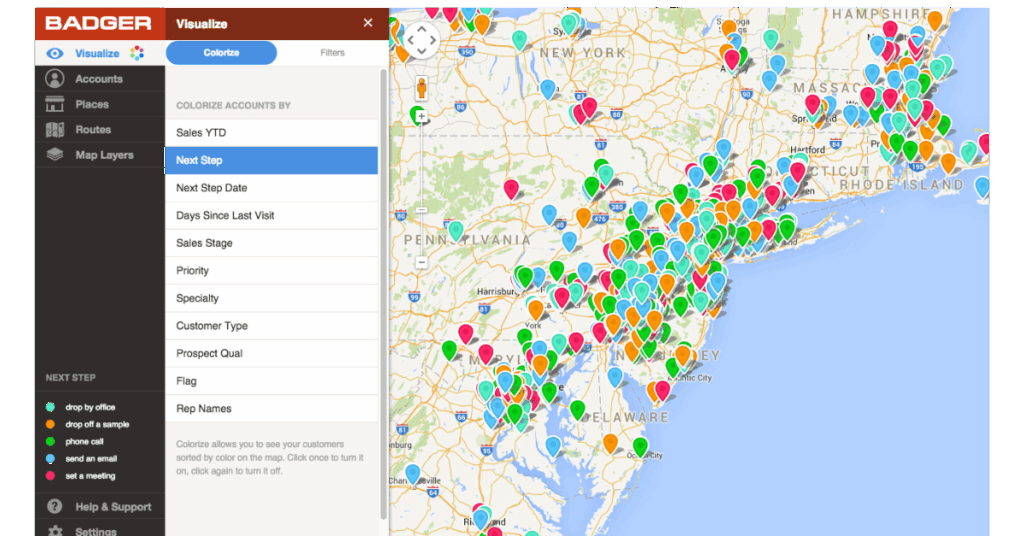
Badger Maps is a popular app for outside sales reps. Its strength lies in visualizing customers on a map, finding nearby accounts, and building optimized daily routes. Reps can filter accounts by priority, schedule follow-ups, and log activities directly from the app.
Key features:
-
What-If Scenarios: Used to test the effects of how certain inputs will alter other metrics on the map.
-
Territory Filters & Modeling: Build optimized territory models automatically, defining the number of territories and customizing which metrics to prioritize.
-
Data Visualization: Visualization tools allow for color coded territories, along with bubble maps and heat maps. Reports can be generated that include pie charts and territory graphs.
Consideration: While excellent for data visualization, Badger Maps is best suited to businesses that regularly adjust sales territories or test multiple scenarios.”
3. SPOTIO
Best for: Larger companies that need structured hierarchies (nested parent–child territories), enhanced ownership to avoid overlap, and user-permission controls—especially where route optimization requires less frequent modification.
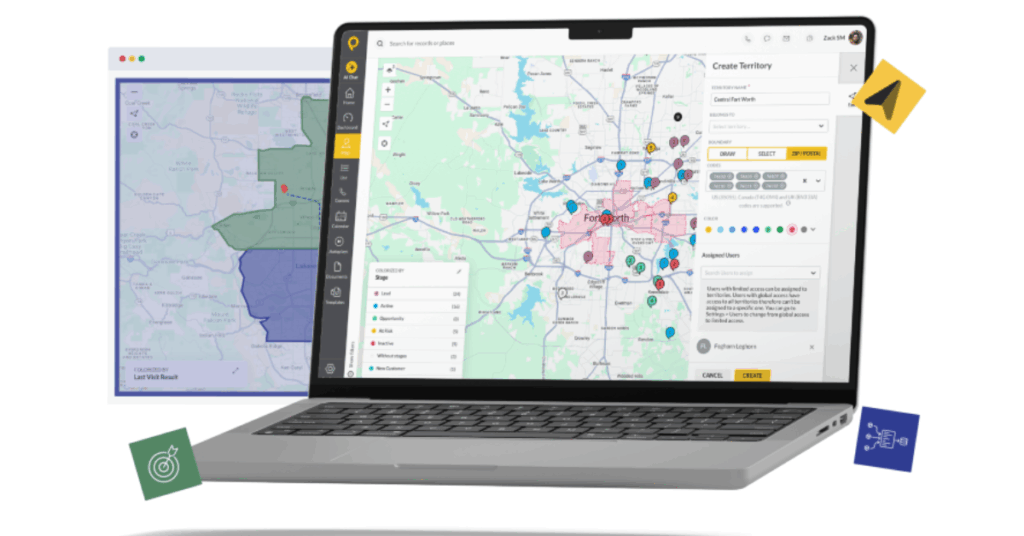
SPOTIO offers strong functionality for sales managers who need to design and assign strict territories for their reps, preventing any overlap and alerting reps when they move outside their territory. Managers can draw territories on maps, allocate them by rep, and measure coverage. Reps can track visits, log customer interactions, and capture data in the field.
Key features:
-
Autovisits: Automatically triggered when reps enter a designated radius around a lead. The app starts a timer to log the duration of the visit, and a note prompt to record information when finished.
-
Territory Hierarchies: Users can nest large “parent” territories containing smaller “child” territories, resulting in a multi layer hierarchy available to supervisors for simplifying regional management for otherwise complex sales structures.
-
Spotio Import Wizard: Offers an alternative to FTP uploads when managing a large number of territories. Through uploading a KML file, 200 territories and 70,000 polygon points can be included.
Consideration: SPOTIO is geared towards larger teams, with an even wider range of customers and sales territories. This means it focuses more on organization, lead management and backend workflows, rather than deep route-optimization or field-sales execution
4. eSpatial
Best for: Enterprises, regional or national sales teams, or companies with multi-layered territories, needing data-driven territory alignment and modeling instead of operational field sales execution.
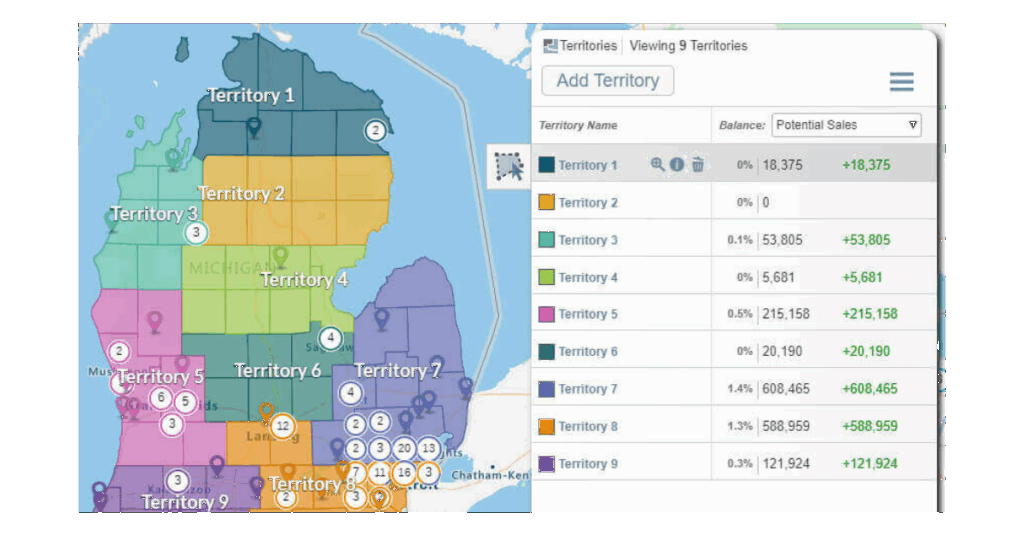
eSpatial is built for more advanced mapping and using data inputs to drive efficiency towards any desired priorities through territory balancing. It helps managers run what-if scenarios, visualize customer and prospect data, and redistribute territories for balanced workloads.
Key features:
-
Alignment Scenarios: Allows for new alignment proposals to quickly reach important decision makers for joint approval.
-
Territory Balancing: Territories can be aligned with weighted balances for stronger alignment between territories. Admins decide how much priority should be assigned to various factors such as workload or travel time, creating a personalized balance applicable for your team’s needs.
-
Find Growth Opportunities. Detect potential openings between your territories by visualizing market gaps, and pinpointing areas with low coverage but high potential.
Consideration: eSpatial is powerful for managers, but may be more complex than necessary for smaller distributor teams, and less rep-friendly than mobile-first tools.
5. Salesforce Maps
Best for: Salesforce-centric enterprises that need CRM-integrated territory management, advanced mapping, and reporting, especially when data consistency and automation inside Salesforce is critical.
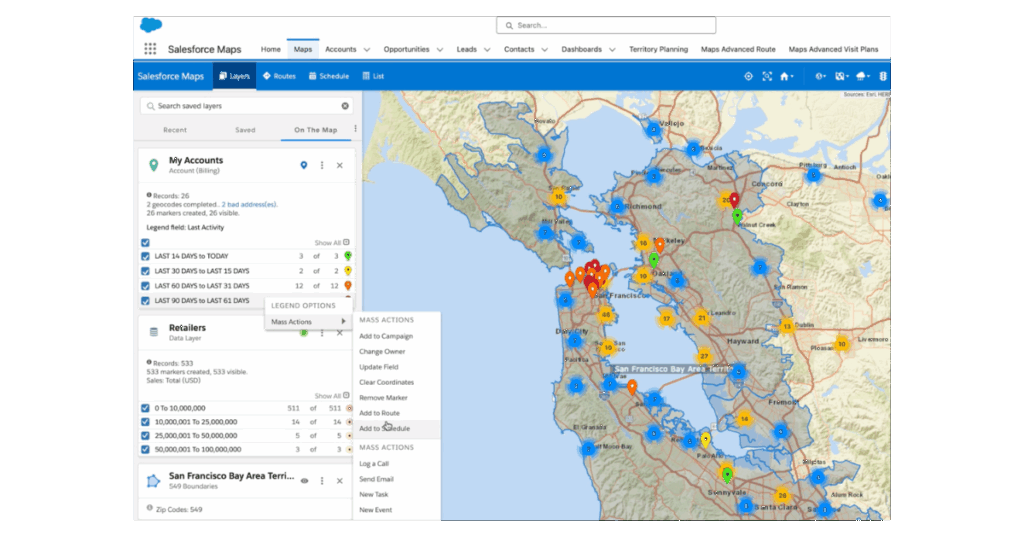
Salesforce Maps extends Salesforce’s CRM by adding mapping and territory features. Reps can visualize accounts, plan routes, and log activity — all within the Salesforce ecosystem.
Key features:
-
CRM-Centric Data: Naturally, since Salesforce Maps is built out from their own CRM, it features the best usage of that data when modifying for planning or performance.
- What-If Scenarios: Used to test the effects of how certain inputs will alter other metrics on the map.
- Territory Hierarchies: Users can nest large “parent” territories containing smaller “child” territories, resulting in a multi-layer hierarchy that helps supervisors manage otherwise complex sales structures.
Consideration: Powerful, but due to the cost, best suited for large enterprises already invested in Salesforce.
How to Choose the Right Territory Management App
When evaluating these apps, distributors should consider:
-
Integration with ERP/Accounting: Can it sync realtime inventory and pricing?
-
Need For Additional Features: Should the software focus in on core sales territory features, or should it include a wider range of features to optimize larger parts of the sales cycle.
-
Ease of Use for Reps: Will reps actually use it in the field without added friction?
-
Cost and Scalability: Does the pricing align with your team size and growth plan?
-
Offline Capability: Critical for reps working in areas with weak connectivity.
Why More Distributors in 2025 Are Choosing inSitu Sales
While tools like Badger Maps, SPOTIO, and eSpatial excel in specific areas, distributors increasingly prefer platforms that cover the entire sales cycle. That’s where inSitu Sales stands out:
-
Field reps can manage territories, take orders, and check inventory in real time.
-
Warehouse teams receive picklists and manage stock efficiently.
-
Dispatchers plan optimized delivery routes with proof-of-delivery tracking.
-
Customers gain 24/7 access through a B2B ecommerce portal.
By consolidating these functions into one solution, inSitu Sales helps distributors cut costs, reduce errors, and maximize rep productivity.
Final Thoughts
Mobile territory management apps are no longer optional — they’re a must-have for distributors in 2025. Whether you need advanced mapping (eSpatial), rep accountability (SPOTIO), or route optimization (Badger Maps), there’s a solution available.
But if your goal is to optimize the entire distribution process — from reps in the field to warehouses and deliveries — while giving customers self-service ecommerce access, then inSitu Sales is the clear choice.
👉 Ready to see how inSitu Sales can help your reps cover more ground and close more orders? Book a free demo today.
